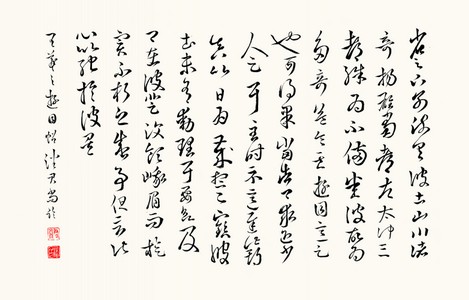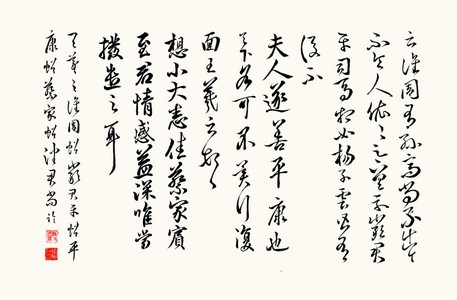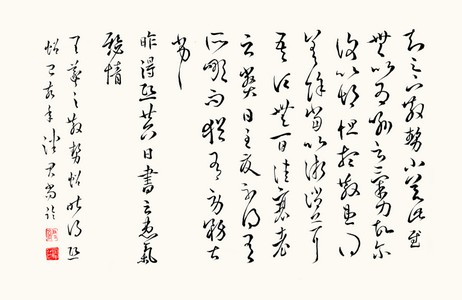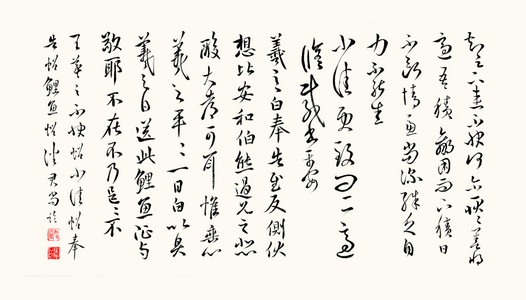Galleries and Translations > Models of Masterpieces > Models of miscellaneous Masterpieces by Wang Xizhi (part III) 臨王羲之諸法帖 (第三部份)
Models of miscellaneous Exemplary Masterpieces by Wang Xizhi (part III) 臨王羲之諸法帖 (第三部份)
Historical information
(I)
Wang Xizhi (王羲之) is often considered to be the most outstanding Chinese calligrapher of all time and is regarded as “The Sage of Calligraphy (書聖)” in China and Japan. Born in 303AD in an upper-class aristocratic family, Wang Xizhi started learning Chinese calligraphy at the age of seven from the renowned calligrapher Wei Shuo (衛鑠 or 衛夫人, 272-349AD). His father, Wang Kuang (王曠, ?-?AD), was a government prefecture chief (太守) and was also a calligrapher. His uncle, Wang Dao (王導, 276-339AD), was the prime minister (丞相) during the reign of Emperor Cheng of the Eastern Jin Dynasty (晉成帝, 321-342AD ). Further biographic information of Wang can be seen on my page regarding Lanting Xu (蘭亭帖).
(II)
The calligraphies presented below are my models of Wang Xizhi's handwriting found in Chunhua Imperial Archive of Calligraphy Exemplars (《淳化閣帖》). Supposedly, these handwritings were short letters and memos scribed by Wang. Although their authenticities are questionable, they are still often regarded as Exemplary Masterpieces (法帖) for calligraphers to study and observe. In the art of Chinese calligraphy, "帖(pronounced as Tie)" refers to an exemplary work that should be studied by all .
(III)
Since the originals in the Chunhua Imperial Archive of Calligraphy Exemplars (《淳化閣帖》) can be parts of or whole letters/memos scribed by Wang, translations that are provided below, if available, may not be entirely precise, for they can be interpreted out of context. Further, whether Wang had actually scribed them remains questionable. Accordingly, scholars should be wary of using these as authentic historical references.
You MuTie (遊目帖):
Original Classical Chinese: 省足下別疏,具彼土山川諸奇,揚雄《蜀都》,左太沖《三都》,殊為不備。悉彼故為多奇,益令其遊目意足也。可得果,當告卿求迎。少人足耳。至時示意。遲此期真,以日為歲。想足下鎮彼土,未有動理耳。要欲及卿在彼,登汶領、峨眉而旋,實不朽之盛事。但言此,心以馳於彼矣。
English: I have read your other letter detailing the marvels and wonders of the hills and moutains at your place (the land of Shu); even Yang Xiong's Shu Du (蜀都賦) nor Zuo Taichong's San Dou can match your thoroughness in description. Having the knowledge of the wonders that your described, it makes one to anticipate even more the satisfaction after surveying them. If the trip is possible, I will contact you to ask for your hospitality. Accommodations for only a few should be sufficient. When the time comes, I will communicate with you. Waiting for that moment is like a year has gone by for each day passed. I believe you have comfortably fortified yourself at your location and so do not have plans nor reasons to travel elsewhere soon. I want to catch you at your place and climb the mountains of Wen Ling (汶領) and Emei (峨眉) together with you; and that would indeed be a uniquely fabulous event. Just writing about it makes my heart race towards where you now reside. (interpreted by KS Vincent Poon based on the vernacular Chinese interpterion below by Professor Lin Li E)
Vernacular Chinese: 在他處看到您(王羲之的好友周撫)寄來的信,備述您那裏(蜀地)山川的種種奇妙,就連楊(揚)雄的蜀都賦、左太沖(思)的三都賦都比不上您的詳盡了。您那裏的山川確實多有奇妙之處,越加令人興起想飽覽一遊其意方足的念頭。果真能實現,當告訴您派人來接,人數不要多。可以去的時間,到時候告訴您。等待這個日子的到來,真有度日如年之感。猜想您鎮守蜀地,一時沒有調動的道理。想要藉著您還在蜀地的日子,與您一起登上汶嶺、峨嵋而歸,這真會是千古不朽的盛事呀!只說到這裏,心已奔馳到您那裏去了! (譯者:林麗娥教授)
A model of Qiao Zhou Tie (譙周帖), Yan Jun Ping Tie (嚴君平帖), and Ping Kang Tie (平康帖)
35 X 54 cm
Click to Enlarge. Reserved, not available in shop.
Qiao Zhou Tie (譙周帖):
Original Classical Chinese: 云譙周有孫高尚不出,(今為所在,其人有以副此志)*不?令人依依,足下具示。
*Absent in 宋拓淳化閣帖 游相本
English: It is said that one of Qiao Zhou's (譙周) grandson is of high character and lives in reclusion. He now resides at your location; is he really the person of such qualities? This matter has always been on my mind and I look forward to your response.
(interpreted by KS Vincent Poon based on the vernacular Chinese interpretation below by Professor Lin Li E)
Vernacular Chinese: 聽說譙周(蜀漢老臣)有個孫子(譙秀)隱居不仕,現在就在您(王羲之的上司桓溫)那兒(蜀地,桓溫於晉穆帝永和三年,帥師平定在蜀自稱漢國的李勢,居留成都三十日,舉賢旌善,蜀人悅之。此王羲之促其訪察先賢後裔,後桓溫果薦舉譙秀,然終不願出仕),不知道此人是否名符其實具此志節?此事令人念念不忘,期待您的回信。
(譯者:林麗娥教授)
Yan Jun Ping Tie (嚴君平帖):
Original Classical Chinese: 嚴君平、司馬相如、楊子雲皆有後否?
English: Do Yan Junping (嚴君平), Sima Xiangru, and Yang Ziyun have any decendant (living in the region of Shu)? (interpreted by KS Vincent Poon based on the vernacular Chinese interpretation below by Professor Lin Li E)
Vernacular Chinese: 嚴君平、司馬相如、楊子雲等(東漢賢者)都有後代(留在蜀地)嗎? (譯者:林麗娥教授)
Ping Kang Tie (平康帖):
Original Classical Chinese: 夫人遂善平康也,足下各可不?冀行復面,王羲之頓首。
English: NA. The entire phrase may not be translated, for the context in which it was written is unknown or uncertain.
A model of San Shi Tie (散勢帖), Shuai Lao Tie (衰老帖), and Zuo De Xi Tie (昨得熙帖)
35 X 54 cm
Click to Enlarge. Reserved, not available in shop.
San Shi Tie (散勢帖):
Original Classical Chinese: 知足下散勢小差,此慰無以為喻,雲氣力故爾,復以胡怛,想散患得差,餘當以漸消息耳。
English: NA. The entire phrase may not be translated, for the context in which it was written is unknown or uncertain.
Shuai Lao Tie (衰老帖):
Original Classical Chinese: 吾頃無一日佳,衰老之獘日至,夏不得有所噉,而猶有勞務,甚劣劣。
English: Lately, there has not been a single day when I was in good health. Every day, another malady of decline and old age appears. [Now,] in the summer, I cannot get myself to eat. It feels like having a tiresome duty. I am very weak. (Translated by Antje Richter & Charles Chace in The Trouble with Wang Xizhi: Illness and Healing in a Fourth-Century Chinese Correspondence (T’oung Pao 103-1-3 (2017) 33-93))
Zuo De Xi Tie (昨得熙帖):
Original Classical Chinese: 昨得熙廿六日書,云患氣,懸情。
English: NA. The entire phrase may not be translated, for the context in which it was written is unknown or uncertain.
A model of Bu Kuai Tie (不快帖), Xiao Jia Tie (小佳帖), Feng Gao Tie (奉告帖), and Li Yu Tie (鯉魚帖)
35 X 62 cm
Click to Enlarge. Reserved, not available in shop.
Bu Kuai Tie (不快帖):
Original Classical Chinese: 知足下連不快。何爾耿耿。善將適。吾積羸困。而下積日不斷。情慮尚深。殊乏自力。不能悉悉。
English: NA. The entire phrase may not be translated, for the context in which it was written is unknown or uncertain.
Xiao Jia Tie (小佳帖):
Original Classical Chinese: 小佳更致問一一,適修載書平安。
English: NA. The entire phrase may not be translated, for the context in which it was written is unknown or uncertain.
Feng Gao Tie (奉告帖):
Original Classical Chinese: 羲之白:奉告慰,反側。伏想比安和,伯熊過見之,悲酸,大都可耳,惟垂心,羲之平平,一日白比具。
English: NA. The entire phrase may not be translated, for the context in which it was written is unknown or uncertain.
Li Yu Tie (鯉魚帖):
Original Classical Chinese: 羲之白:送此鯉魚征與敬耶,不在不,乃邑邑不。
English: NA. The entire phrase may not be translated, for the context in which it was written is unknown or uncertain.



